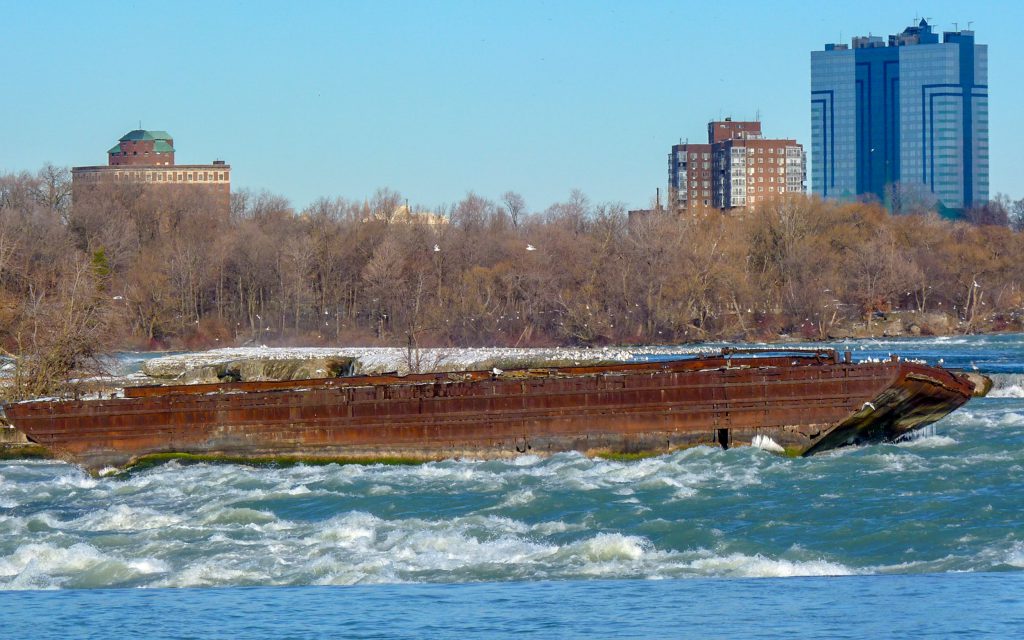A century ago, Niagara Falls played host to a daring rescue. Two men teetered on the edge of life and death, fighting the force of mother nature herself.
The near-fatal incident and legendary rescue was witnessed by thousands in 1918, and remains an often-told story in the Niagara Falls area. Evidence of this history still sits along the banks near the Niagara Falls. Perhaps you have seen it yourself: The Niagara Scow.
ナイアガラ・スカウの話を聞いたことがありますか?
ナイアガラの滝を訪れる人は、この難破船の残骸を見てよく質問します。いつ、どのように、難破が起こったのか?ナイアガラ船首の人々は生き残ったのですか?なぜスカウは、最初の場所で強力なナイアガラの滝に非常に近かったのですか?
本日は、謎に包まれたナイアガラ・スコウにまつわる真実の歴史をご紹介します。
1918年8月6日
On a warm summer afternoon, a steel-bottomed sand barge made its way down the Niagara River carrying 2,000 tons of rock and sand. A barge, also known as a scow, is a flat-bottomed vessel attached to a tugboat.
At least…scows are supposed to be attached to a tugboat.
On that day, however, an unpleasant surprise greeted Captain John Wallace and his crew on the Hassayampa tug. The barge hit intense currents about one mile upriver and broke loose of the tug, swaying out of control as it made its way towards the 170-foot drop of the Horseshoe Falls.
Two crew members, 53-year-old James Henry Harris and 51-year-old Gustav Lofberg, were stuck aboard the scow as it inched closer to the edge. What were they to do?
ジェームズとグスタフの危機一髪
想像できますか?ジェームズ・ヘンリー・ハリスとグスタフ・ロフバーグは、漂流する船の上で恐怖とパニックを感じたに違いない。ホースシューフォール(Horseshoe Falls)に向かって真っすぐに進む二人にできることは、ただ見守ることと希望を持つことだけだった。
何百人もの人々が、急流を進むはしけを見ようと集まったが、乗っていた男たちを助け出すことは誰もできなかった。重いバージは制御不能であり、ナイアガラの滝の発電所を守るために作られた第一次世界大戦中の数々のセキュリティ対策で周囲が封鎖されていたのだ。見物人は、有刺鉄線と警備員の壁の向こうに立って、男たちが恐ろしい落下地点に近づいていくのを見守るしかなかった。

ホースシューフォール(Horseshoe Falls)の滝壺まであと半マイルというところで、観客の恐怖は安堵と喜びに変わった。なんと、船は岩の浅瀬に着岸したのだ。ロフバーグとハリスはすぐにアンカーを投入し、その場を確保した。
一時は助かったが、船頭の話はまだ終わらない。しかし、まだ話は終わっていなかった。レスキュー隊が簡単にたどり着けるわけがない。
今、彼らに何ができるのか?
レスキュー
ハリスとロフバーグは上陸を決意したが、その方法は限られていた。ハリスとロフバーグは上陸を決意したが、その方法は限られていた。
参考までに、「ウインドラス」のイメージを以下に示すが、本来は重い重りを動かすための器具である。

彼らは、救助隊が何とかして海岸から自分たちの腰掛までロープを伸ばしてくれることを願った。そして、そのロープをウインドラス(巻き上げ機)で台船に固定することを望んだ。
もちろん、これはハイリスクな提案だった。巻き上げ機は信頼性に欠け、テストもされていない。もし、ロープでしっかりつながれていない状態でボートが岩から外れたら、ホースシューフォール(Horseshoe Falls)を越えて下降することになり、命にかかわる危険性がある。
ロープが2人の元に届いたのは、日暮れ時だった。ロープが2人の元に届いたのは日暮れ時で、ウインドラスは船を動かすことができず、救助隊はロープを使って船と発電所の間にブリーチングブイを固定しようとした。
参考までに、1884年に描かれた、救助に成功したブリーチングブイがどのように機能するかを示す絵を紹介しよう。

ハリスとロフバーグにとって残念なことに、最初のブリーチング・ブイの試みは失敗に終わった。ロープが途中で絡まり、時計が真夜中に近づくにつれ、救助隊員はロープを直すには暗すぎるということで意見が一致した。救助は朝方まで延期されたが、サーチライトは点灯したままであり、男たちは自分たちのことを忘れてはいないと安心していた。
1918年8月7日
翌朝、太陽が昇ると、その光景を見ようと人々が集まってきた。この日のストーリーが、勝利の救出劇になるのか、それとも破滅的な失敗劇になるのかはまだわからないが、何千人もの人々がその展開を見届けようと集まってきた。
幸運なことに、閉じ込められた船頭たちにとって、群衆は良い知らせとともに帰路についた。この日のヒーローは、伝説の川人ウィリアム・"レッド"・ヒル・シニアだった。彼は何時間もかけてブリーチズ・ブイを解き、水面を渡って取り残された男たちのもとへ向かった。
この救助には、試行錯誤とロープの絡まり、そして自分の命をかけて2人を救った勇敢なレスキュー隊員など、全体で17時間を要した。ヒルはその功績により、カーネギーメダルを授与された。

ナイアガラ・スコウの神話と噂
After witnessing the narrow escape, onlookers soon began swapping accounts of what happened that day. Some were quite far-fetched – one particularly outlandish rumour was that the two boatmen had cut two holes in the bottom of their scow to let water enter the vessel and force it to the beach. However, this would have taken too long with the materials on board. The scow landing on the rocks was luck, pure and simple.
There are other stories, however, which may be more rooted in fact. For example, some people swear they saw the two men attempting to control the barge using makeshift oars. Others claimed that they moved some of the load to the front of the scow once it was secured on the rock, in hopes of keeping it steady. We don’t know if these stories are true for certain; all we do know is that whatever Harris and Lofberg did (or didn’t do), it worked out. What could have been a devastating news story was instead a triumph for the people of Niagara Falls.
ナイアガラ・スコウの一世紀後
19世紀のハネムーナーの絵葉書に大胆な急落に使用されるバレルから、ナイアガラの滝の歴史のほとんどの遺物は、長いので、有名なウォーターフロントを残している。観光客は、一般的にガラスケースを通してアーティファクトをのぞき、ナイアガラの滝のボートツアーや博物館の訪問で解説を通して過去を垣間見る。
しかし、よく見ると、ナイアガラ川の土手には、まだ歴史の一片が残されているのだ。
The story of Lofberg and Harris’s rescue is uniquely extreme, but the history of people risking their lives to generate power at the Niagara Falls is far-reaching. Workplace injuries and even fatalities were not uncommon for power workers, especially in the early days of the Niagara Falls Hydro Plant. After all, an engineering project involving such a fierce natural spectacle as the Niagara Falls is often a high-risk undertaking.
Today, the Niagara Scow is still lodged in those rocks on the fast-flowing Niagara River. It serves as a constant reminder of the risks and the determination involved in harnessing the power of one of the world’s most spectacular natural wonders.



